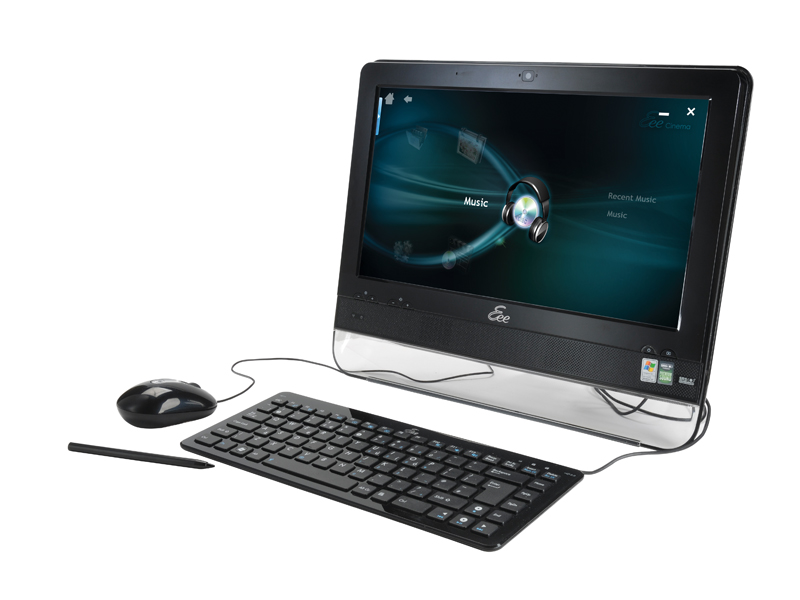TechRadar Verdict
Brilliant concept, well built and hopefully will be the first of many touchscreen desktops
Pros
- +
Very accurate touchscreen
- +
Intelligent customisation of XP
- +
Reasonably priced
Cons
- -
Should come with wireless peripherals
Why you can trust TechRadar
The Eee has evolved again into a neat Apple iMac-like desktop PC, but where the £200 Eee Box offered a barebones approach, the Eee Top is a PC/monitor combo with touchscreen input.
The original Eee netbook was impressive enough, but the Eee Top trumps it technologically: it's a fully fledged and stylish desktop with a tiny footprint – perfect for the lounge or kitchen as a second PC.
We loved the system's looks and build-quality, and were pleasantly surprised by the resilience of the chassis. However, the Eee Top is all about the screen and at this affordable price point it's heartening to see that not only is it bright and clear, with an unusual resolution of 1,366 x 768, its touch capabilities are every bit as good as the best smartphones or tablet PCs around.
This is aided by Asus' excellent adaptation of Windows XP; there are some smart features that make the most of the touch medium.
Windows hybrid
It's been made to resemble the tab-based version of Xandros Linux that was installed on the original Eee PC, but here it sits on top of Windows XP Home and integrates very well with Microsoft's venerable operating system through the use of a speedy quick-launch bar.
Whereas the original Eee netbook had a distinctly student or mobile worker feel about it, the Eee Top is truly a family computer, which is where a touchscreen interface comes into its own. A simple icon-driven interface makes using the Eee Top simple for children, and is fun and fast for adults, too.
Asus' Easy Mode enables users to locate and access commonly used applications easily within streamlined and readily accessible menus. This makes Windows immediately intuitive to any level of user of any age.
Fingertip control
The four Easy Mode tabs house the majority of the Eee Top's applications. The first, Communication, takes care of Skype, email and web apps, with direct links to popular sites such as Windows Live Mail, Gmail, Facebook, MySpace and Blogger.
The Fun tab contains media-handling software, which is similar to Windows Media Center's own interface, and also features some games. The Work area is where you'll find vital office apps, a PDF reader and calculator and, finally, Tools is the location of the default web browser (Internet Explorer).
All these areas – in fact any of the usual Windows XP options – can be accessed by pressing the screen with your fingers, but to avoid fingerprints a stylus is also included.
For ease of storage the stylus can be slotted into the rear of the keyboard, but because the Asus icons are so large it's fun to use your fingers instead, which is particularly good for scrolling down website pages.
There are a number of Asus applications that make the most of touch, too. Eee Memo, for example, enables users to write messages for their family members on desktop "stickies" with just their fingers.
SoftStylus makes it possible to input text without requiring a physical keyboard and also offers a virtual keyboard as an alternative. Web browser Opera Touch also supports intuitive drag-and-drop functions.
Best ever XP?
Like any PC manufacturer Asus tends to load its machines with its own tools. Whereas laptop owners may get a little frustrated by this, the Eee Top benefits hugely. If anything it enhances Windows XP way beyond its original intentions. The OS is totally refreshed on the Eee Top with a new default font and a brilliant response time when using the touchscreen.
From a hardware aspect XP runs smoothly on 1GB RAM, despite only a 5,400rpm speed hard drive. Six USB 2.0 ports give ample expansion options, although one may be permanently in use if you attach an external CD-ROM drive (the system lacks a built-in optical drive). Indeed, it's surprising to see that a side-mounted slot drive is missing, because the unit is wider than the new Apple iMacs.
Despite its bargain price we're betting that the Eee Top won't match the popularity of the netbook Eees, with laptops sales continuing to outshine desktops. Yet, if it's a second desktop you're after then this is £430 well spent, and a machine that young and old will enjoy equally.
